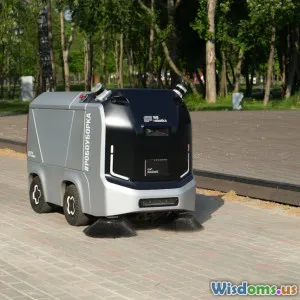
How AI Can Transform the Future of Car Safety
7 min read Explore how AI innovations are revolutionizing car safety, reducing accidents, and paving the way for safer roads worldwide. (0 Reviews)
How AI Can Transform the Future of Car Safety
Introduction
Imagine a world where car accidents become a rarity rather than a daily hazard. This is closer to reality today than ever before, largely thanks to the advancements in Artificial Intelligence (AI). AI's integration into automobiles marks a pivotal step toward radically safer roads. As one of the leading technologies disrupting the traditional landscapes of transportation, AI can analyze complex data in real-time and assist drivers—or even replace them—to prevent accidents before they happen. This article dives deep into the transformative potential of AI in car safety, highlighting key innovations, real-world applications, and their broader impact on society.
The Current Landscape of Car Safety Technologies
Today, many vehicles come equipped with Advanced Driver Assistance Systems (ADAS) such as lane departure warnings, adaptive cruise control, and automatic emergency braking. These features rely on sensors and cameras to detect obstacles and hazards. However, the evolution from simple alert-based systems to predictive AI-driven controls is where the future lies.
Limitations of Traditional Systems
Despite their benefits, traditional safety technologies have limitations:
- Static Response: Most ADAS respond reactively based on preset thresholds rather than context-aware analysis.
- Sensor Blind Spots: Cameras or radars can be impaired by weather or poor visibility conditions.
- Human Factor: Drivers may ignore warnings or fail to react appropriately.
AI addresses these gaps by enabling dynamic decision-making and deeper environmental understanding.
How AI Enhances Car Safety
1. Real-Time Hazard Detection and Prediction
AI algorithms process inputs from multiple vehicle sensors and external data feeds (like traffic or weather reports) to identify not only immediate dangers but also anticipate potential hazards. For instance, Tesla’s Autopilot uses neural networks trained on millions of miles of driving data to predict and respond to complex scenarios, such as sudden braking by cars ahead or pedestrians entering the road.
2. Advanced Driver Monitoring Systems (DMS)
Fatigue or distraction contributes to a significant percentage of accidents globally. AI-powered DMS can monitor driver behavior using facial recognition and eye-tracking to detect signs of drowsiness or inattentiveness and issue alerts or even intervene. For example, Volvo’s upcoming vehicles are integrating AI to monitor attention levels and suggest breaks, significantly reducing fatigue-related crashes.
3. Vehicle-to-Everything (V2X) Communication
AI plays a critical role in enabling V2X systems that allow cars to communicate with other vehicles, infrastructure, and even pedestrians. This networked intelligence greatly improves situational awareness and coordination to prevent crashes. A notable example is Audi’s traffic light recognition system, which uses AI to optimize braking and acceleration by communicating with city traffic systems, enhancing fuel efficiency and safety.
4. Autonomous Emergency Response
When an accident is no longer avoidable, AI-enabled systems can mitigate severity by imposing controlled braking, adjusting seat belts, and deploying airbags in an optimal manner. In 2019, Mercedes-Benz introduced PRE-SAFE Impulse Side, which uses AI to detect imminent side collisions and prepares the vehicle and occupants accordingly, reducing injury risks.
Impact and Statistical Insights
According to the National Highway Traffic Safety Administration (NHTSA), human error contributes to about 94% of car accidents. AI-driven technologies, with their rapid data processing and predictive analytics capabilities, have shown promise in cutting down these numbers dramatically. For instance, a study published by the Insurance Institute for Highway Safety (IIHS) found that forward collision warning combined with automatic emergency braking reduced rear-end crashes by 50%. As AI matures, reductions can extend to various accident types, including side and pedestrian collisions.
Challenges in AI-Driven Car Safety
Despite these promising advances, AI implementation in car safety is not without challenges:
- Data Privacy: The vast data used for AI training and operation raises concerns about user privacy and security.
- Ethical Dilemmas: AI may face scenarios requiring critical choices, such as the "trolley problem," complicating programming ethics.
- Liability Issues: Determining responsibility in case of AI-system failures is legally complex.
- Technology Accessibility: Ensuring these AI safety systems are affordable and widespread remains a hurdle.
Addressing these challenges necessitates multi-sector collaboration between automakers, regulators, and ethicists.
The Road Ahead: Future Innovations
Emerging technologies promise even more transformative impacts, such as:
- AI-Driven Predictive Maintenance: Identifying potential mechanical failures before they escalate, thereby preventing breakdown-induced accidents.
- Enhanced Sensor Fusion: Combining data from LiDAR, radar, and cameras through AI to form a more precise understanding of the vehicle’s environment.
- Personalized AI Assistants: Tailoring AI systems to individual driver habits to provide customized safety interventions.
Conclusion
Artificial Intelligence stands as a game-changer in the quest for safer roads. Its ability to foresee dangers, monitor driver behavior, facilitate communication, and respond autonomously heralds a new era in car safety. While challenges remain, the advancements already made suggest a future where vehicular accidents could be enormously reduced or even eliminated. Embracing these technologies not only promises enhanced safety but also moves society toward smarter, more sustainable transportation.
As consumers and technology enthusiasts, staying informed and encouraging the adoption of AI-driven safety innovations can contribute to more secure journeys and ultimately save lives on roads worldwide.
Ready to embrace the future? Supporting AI integration in vehicle safety systems is more than a tech upgrade—it's a vital step toward saving lives.
Rate the Post
User Reviews
Popular Posts




















